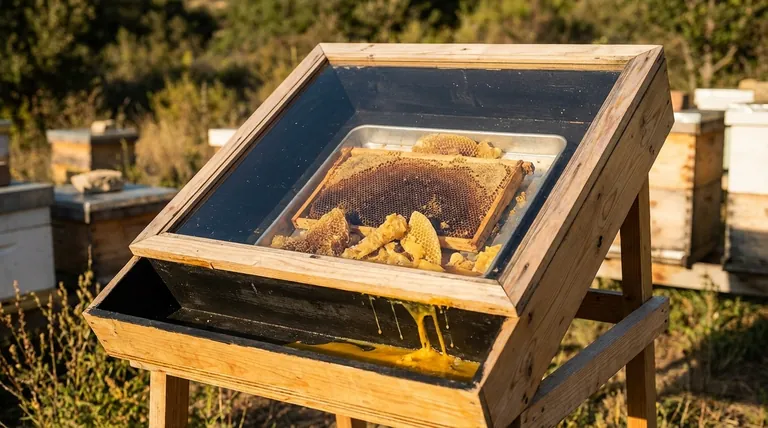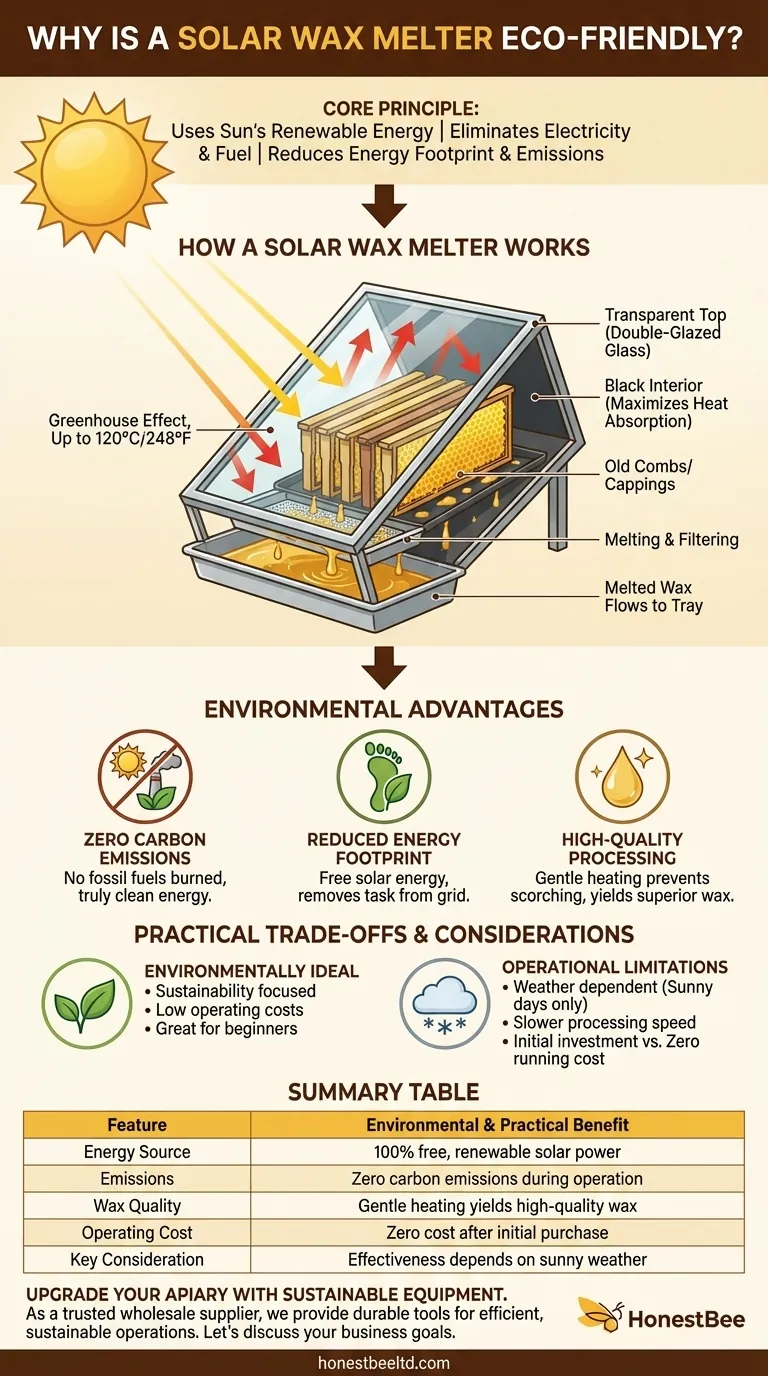At its core, a solar wax melter is considered eco-friendly because it uses the sun's renewable energy to melt and purify beeswax. This eliminates the need for electricity or combustible fuels, significantly reducing the energy footprint of the process and avoiding the creation of harmful emissions.
A solar wax melter leverages passive solar gain to perform a task that would otherwise require electricity or fuel. This makes it a zero-emission, zero-operating-cost tool that aligns the beekeeper's workflow with sustainable principles.

How a Solar Wax Melter Works
A solar wax melter is a simple yet highly effective device designed to harness solar radiation. Its efficiency comes from a few key design principles that work in concert.
Harnessing Solar Energy
The melter is essentially a well-insulated box with a transparent top, typically made of high-strength double-glazed glass. This glass allows sunlight to enter but traps the resulting heat inside, creating a greenhouse effect.
To maximize heat absorption, the interior is often painted black, and the entire unit is tilted to face the sun directly. Under direct sunlight, internal temperatures can reach as high as 120°C (248°F).
The Melting and Filtering Process
Old honeycombs, cappings, or blocks of unprocessed wax are placed inside the melter. They can be hung on frames or laid on a stainless steel plate designed for uniform heat distribution.
As the internal temperature rises, the wax melts. The melter is built at an angle, causing the liquid wax to flow downwards into a collection tray. Often, a sieve is placed in the path of the wax to filter out impurities like propolis, cocoons, and other debris during the melting process.
The Environmental Advantages Explained
The eco-friendly nature of a solar melter goes beyond simply using sunlight. It has a cascading positive impact on the sustainability of a beekeeping operation.
Zero Carbon Emissions
By relying solely on solar power, the device produces no carbon emissions. It replaces processes that would otherwise consume electricity (often generated by fossil fuels) or directly burn propane, making it a truly clean energy solution.
Reducing the Overall Energy Footprint
Processing wax can be an energy-intensive task. A solar melter removes this task from the electrical grid or fuel budget entirely. Its operating energy is free, abundant, and has no associated environmental cost.
High-Quality, Sustainable Processing
The slow and gentle heating process not only saves energy but also produces a higher quality final product. It prevents the wax from scorching, which can happen with direct heating methods, resulting in clean, beautifully colored wax ready for use in candles, cosmetics, or new foundation sheets.
Understanding the Practical Trade-offs
While environmentally ideal, a solar wax melter has operational limitations that are important to understand. Its effectiveness is entirely dependent on a key factor you cannot control.
Dependence on Weather
The most significant trade-off is its reliance on sunlight. The melter is only effective on sunny, warm days. It is not a solution for rapid, on-demand processing and will not function on cloudy days or during winter months in many climates.
Slower Processing Speed
The melting process is slow and controlled. While this is beneficial for wax quality, it is not suited for beekeepers who need to process very large volumes of wax quickly. Commercial operations often require faster, powered alternatives to keep up with demand.
Upfront Cost vs. Zero Operating Cost
While the melter costs nothing to run, a well-built, durable unit represents an initial financial investment. However, this cost is offset over time by the complete elimination of electricity or fuel expenses for wax rendering.
Making the Right Choice for Your Apiary
A solar wax melter is a powerful tool when used for the right purpose. Your goals will determine if it's the correct choice for your beekeeping practice.
- If your primary focus is sustainability and low operating costs: A solar melter is an unparalleled choice that perfectly aligns with eco-friendly principles.
- If your primary focus is simplicity and ease of use: These devices are ideal for beginners, as they require no energy inputs and minimal labor.
- If your primary focus is high-volume or on-demand processing: A solar melter is best used as a supplementary tool, while an electric or gas-powered unit will be necessary for your core workflow.
By choosing tools that harness natural energy, you integrate sustainable practices directly into the art of beekeeping.
Summary Table:
| Feature | Environmental & Practical Benefit |
|---|---|
| Energy Source | 100% free, renewable solar power |
| Emissions | Zero carbon emissions during operation |
| Wax Quality | Gentle heating prevents scorching, yields high-quality wax |
| Operating Cost | Zero cost for energy after initial purchase |
| Key Consideration | Effectiveness depends on sunny weather |
Upgrade your apiary with sustainable, cost-effective equipment from HONESTBEE.
As a trusted wholesale supplier for commercial apiaries and distributors, we provide the durable tools you need to operate efficiently and sustainably. A solar wax melter is just one way to reduce your costs and environmental impact.
Let's discuss how our range of beekeeping supplies can support your business goals. Contact our team today for wholesale pricing and expert advice.
Visual Guide

Related Products
- Professional Stainless Steel Wax Melter for Beekeeping and Crafts
- Beeswax Melter for Candle Making Honey Bee Wax Melter
- Steam Beeswax Melter Wax Warmer for Wax Processing
- Electric Beeswax Flat Sheet Machine with Operating Tray for Wax Processing
- Honey Wax Separating Wax Press with Metal Screw Wax Separator Machine
People Also Ask
- What are the steps for using a wax melter to melt beeswax? Master Safe, Efficient Beeswax Processing
- Can I melt beeswax in a wax melter? The Key to Safe, High-Quality Results
- How can you monitor the temperature of beeswax as it melts? Ensure Quality & Safety with Precise Control
- What is the flashpoint of beeswax? Essential Safety and Quality Tips for Beekeepers
- What are wax melters used for? Unlock Efficient Wax Processing for Your Business



















